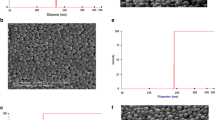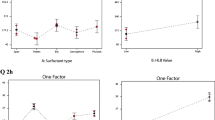Abstract
Hydrogen sulfide (H2S) targets both underlying factors in glaucoma pathogenesis by reducing elevated intraocular pressure (IOP) and providing retinal neuroprotection, whereas the current clinical approaches targets only reducing IOP. Therefore, H2S could be a potential superior candidate for glaucoma pharmacotherapy. However, H2S could be toxic in a concentration greater than 200 μM and its donors are unstable in water. Therefore, this study investigated the preparation and characterization of a non-aqueous in situ gelling sustained-release delivery system for H2S donors. The delivery system was prepared by dissolving GYY 4137, a H2S donor, in poly lactide-co-glycolide polymer (PLGA) (Resomer® RG 502H) solution prepared by dissolving polymer in a mixture of benzyl alcohol and benzyl benzoate in a ratio of 7:3, respectively. The GYY 4137 formulation was characterized for syringeability/injectability, change in pH and tonicity, moisture content, GYY 4137 degradation, and toxicity using rheometer, pH and osmometer, Karl Fisher titrimeter, NMR spectrometer, and Y79 retinoblastoma cells, respectively. The formulation was easily syringeable and injectable as evidenced by rheological data (plastic flow pattern with 43.89 ± 3.21 cP viscosity and 1.12 ± 0.15 Pa yield value). The pH, tonicity, and moisture content values were within acceptable range. NMR spectroscopy indicated presence of 4-methoxyphenylphosphonic acid (GYY 4137 degradation product). The GYY 4137 formulation did not show any significant (p < 0.05) toxicity except the solvent mixture. A sustained release of H2S was observed up to 72 h. The in situ gel forming PLGA-based system can be manipulated to achieve sustained release of H2S from its donor GYY 4137.









Similar content being viewed by others
REFERENCES
National Eye Health Education Program (NEHEP). https://nei.nih.gov/nehep/gam/. Accessed 23 Sep 2016.
Bulletin of the World Health Organization (WHO). Glaucoma is second leading cause of blindness globally. 2004. http://www.who.int/bulletin/volumes/82/11/feature1104/en/. Accessed 23 Sep 2016.
Glaucoma facts and stats. http://www.glaucoma.org/glaucoma/glaucoma-facts-and-stats.php. Accessed 23 Sep 2016.
Alvarado J, Murphy C, Polansky J, Juster R. Age-related changes in trabecular meshwork cellularity. Invest Ophthalmol Vis Sci. 1981;21:714–27.
Chrysostomou V, Rezania F, Trounce I, Crowston J. Oxidative stress and mitochondrial dysfunction in glaucoma. Curr Opin Pharmacol. 2013;13:12–5.
Fliesler SJ. Lipids and lipid metabolism in the eye. J Lipid Res. 2010;51:1–3.
Izzotti A, Bagnis A, Saccà SC. The role of oxidative stress in glaucoma. Mutat Res. 2006;612:105–14.
Tezel G. The role of glia, mitochondria, and the immune system in glaucoma. Invest Ophthalmol Vis Sci. 2009;50:1001–12.
Dahlmann-Noor A, Vijay S, Limb GA, Khaw P. Strategies for optic nerve, rescue and regeneration in glaucoma and other optic neuropathies. Drug Discov Today. 2010;15:287–99.
Vasudevan SK, Gupta V, Crowston JG. Neuroprotection in glaucoma. Indian J Ophthalmol. 2011;59:S102–13.
Chua B, Goldberg I. Neuroprotective agents in glaucoma therapy: recent developments and future directions. Expert Rev Ophthalmol. 2010;5:627–36.
Lichter PR, Musch DC, Gillespie BW, Guire KE, Janz NK, Wren PA, et al. Interim clinical outcomes in the Collaborative Initial Glaucoma Treatment Study comparing initial treatment randomized to medications or surgery. Ophthalmology. 2001;108:1943–53.
Heijl A, Leske MC, Bengtsson B, Hyman L, Bengtsson B, Hussein M. Reduction of intraocular pressure and glaucoma progression: results from the Early Manifest Glaucoma Trial. Arch Ophthalmol. 2002;120:1268–79.
Ji J, Elyaman W, Yip HK, Lee VW, Yick LW, Hugon J, et al. CNTF promotes survival of retinal ganglion cells after induction of ocular hypertension in rats: the possible involvement of STAT3 pathway. Eur J Neurosci. 2004;19:265–72.
Mansour-Robaey S, Clarke DB, Wang YC, Bray GM, Aguayo AJ. Effects of ocular injury and administration of brain-derived neurotrophic factor on survival and regrowth of axotomized retinal ganglion cells. Proc Natl Acad Sci U S A. 1994;91:1632–6.
Peinado-Ramón P, Salvador M, Villegas-Pérez MP, Vidal-Sanz M. Effects of axotomy and intraocular administration of NT-4, NT-3, and brain-derived neurotrophic factor on the survival of adult rat retinal ganglion cells. A quantitative in vivo study. Invest Ophthalmol Vis Sci. 1996;37:489–500.
Osborne NN. Pathogenesis of ganglion “cell death” in glaucoma and neuroprotection: focus on ganglion cell axonal mitochondria. Prog Brain Res. 2008;173:339–52.
Osborne NN, Ji D, Majid ASA, Del Soldata P, Sparatore A. Glutamate oxidative injury to RGC-5 cells in culture is necrostatin sensitive and blunted by a hydrogen sulfide (H2S)-releasing derivative of aspirin (ACS14). Neurochem Int. 2012;60:365–78.
Jia J, Xiao Y, Wang W, Qing L, Xu Y, Song H, et al. Differential mechanisms underlying neuroprotection of hydrogen sulfide donors against oxidative stress. Neurochem Int. 2013;62:1072–8.
Li J, Benashski SE, Venna VR, McCullough LD. Effects of metformin in experimental stroke. Stroke. 2010;41:2645–52.
Zhao W, Zhang J, Lu Y, Wang R. The vasorelaxant effect of H2S as a novel endogenous gaseous KATP channel opener. EMBO J. 2001;20:6008–16.
Olson KR. Is hydrogen sulfide a circulating “gasotransmitter” in vertebrate blood? Biochim Biophys Acta. 1787;2009:856–63.
Kimura Y, Dargusch R, Schubert D, Kimura H. Hydrogen sulfide protects HT22 neuronal cells from oxidative stress. Antioxid Redox Signal. 2006;8:661–70.
Kimura Y, Kimura H. Hydrogen sulfide protects neurons from oxidative stress. FASEB J. 2004;18:1165–7.
Weisova P, Davila D, Tuffy LP, Ward MW, Concannon CG, Prehn JH. Role of 5′-adenosine monophosphate-activated protein kinase in cell survival and death responses in neurons. Antioxid Redox Signal. 2011;14:1863–76.
Perrino E, Uliva C, Lanzi C, Soldato PD, Masini E, Sparatore A. New prostaglandin derivative for glaucoma treatment. Bioorg Med Chem Lett. 2009;19:1639–42.
Salvi A, Bankhele P, Jamil J, Chitnis MK, Njie-Mbye YF, Ohia SE, et al. Effect of hydrogen sulfide donors on intraocular pressure in rabbits. J Ocul Pharmacol Ther. 2016;32:371–5.
Njie-Mbye YF, Robinson J, Okpobiri A, Chitnis M, Opere C, Ohia S. Effect of NaHS, a fast-releasing hydrogen sulfide donor on aqueous humor outflow in porcine trabecular meshwork. Invest Ophthalmol Vis Sci. 2013;54:3563.
Alexander BE, Coles SJ, Fox BC, Khan TF, Maliszewski J, Perry A, et al. Investigating the generation of hydrogen sulfide from the phosphonamidodithioate slow-release donor GYY4137. Med Chem Commun. 2015;6:1649–55.
Bhatia M. Role of hydrogen sulfide in the pathology of inflammation. Scientifica (Cairo). 2012;2012:159680.
Muniraj N, Ang AD, Badiei A, Rivers-Auty J, Bhatia M. Hydrogen sulfide: a new tool to design and develop drugs. Clin Antiinflamm Anti-Allergy Drugs. 2014;1:57–66.
Ali H, Opere C, Singh S. In vitro-controlled release delivery system for hydrogen sulfide donor. AAPS PharmSciTech. 2014;15:910–9.
Ang AD, Konigstorfer A, Giles GI, Bhatia M. Measuring free tissue sulfide. Adv Biol Chem. 2012;2:360–5.
Validation of compendial procedures, USP 39, pp. 1640-6, http://www.uspnf.com/uspnf/pdf/download?usp=39&nf=34&s=2&q=usp39nf34s2_c1225.pdf&officialOn=December%201,%202016&target=oldwindow&time=1481557962512. Accessed 12 Dec 2016.
Hayton WL, Chen T. Correction of perfusate concentration for sample removal. J Pharm Sci. 1982;71:454–8.
Bravo-Altamirano K, Montchamp JL. A novel approach to phosphonic acids from hypophosphorous acid. Tetrahedron Lett. 2007;48:5755–9.
GYY 4137 Product Insert, Cayman chemicals specification. https://www.caymanchem.com/pdfs/13345.pdf. Accessed 23 Sep 2016.
Takeda M, Haga M, Yamada H, Kinoshita M, Otsuka M, Tsuboi S, et al. Ionotropic glutamate receptors expressed in human retinoblastoma Y79 cells. Neurosci Lett. 2000;294:97–100.
The Editors of Molecular Vision. On authentication of cell lines. Mol Vis. 2013;19:1848–51.
Carroll JJ, Mather AE. The solubility of hydrogen sulphide in water from 0 to 90°C and pressures to 1 MPa. Geochim Cosmochim Acta. 1989;53:1163–70.
Hughes MN, Centelles MN, Moore KP. Making and working with hydrogen sulfide: the chemistry and generation of hydrogen sulfide in vitro and its measurement in vivo: a review. Free Radic Biol Med. 2009;47:1346–53.
Li L, Whiteman M, Guan YY, Neo KL, Cheng Y, Lee SW, et al. Characterization of a novel, water-soluble hydrogen sulfide-releasing molecule (GYY4137): new insights into the biology of hydrogen sulfide. Circulation. 2008;117:2351–60.
Lee ZW, Zhou J, Chen CS, Zhao Y, Tan CH, Li L, et al. The slow-releasing hydrogen sulfide donor, GYY4137, exhibits novel anti-cancer effects in vitro and in vivo. PLoS One. 2011;6, e21077.
Meng G, Zhu J, Xiao Y, Huang Z, Zhang Y, Tang X, et al. Hydrogen sulfide donor GYY4137 protects against myocardial fibrosis. Oxidative Med Cell Longev. 2015;2015:691070. doi:10.1155/2015/691070.
Whiteman M, Zhou, Perry A, Bucci M, Papapetropoulos A, Cirino G, et al. Phospinodithioate and phosphoramidodithioate hydrogen sulfide donors. Handb Exp Pharmacol. 2015;230:337–63.
Thomsen M, Hernandez-Garcia A, Mathiesen J, Poulsen M, Sørensen DN, Tarnow L, et al. Model study of the pressure build-up during subcutaneous injection. PLoS One. 2014;9, e104054.
Rathore KS. Insitu gelling ophthalmic drug delivery system: an overview. Int J Pharm Sci. 2010;2:30–4.
Cilurzo F, Selmin F, Minghetti P, Adami M, Bertoni E, Lauria S, et al. Injectability evaluation: an open issue. AAPS PharmSciTech. 2011;12:604–9.
Miller MA, Engstrom JD, Ludher BS, Johnston KP. Low viscosity highly concentrated injectable nonaqueous suspensions of lysozyme microparticles. Langmuir. 2010;26:1067–74.
Whiteman M, Moore PK. Hydrogen sulfide and the vasculature: a novel vasculoprotective entity and regulator of nitric oxide bioavailability? J Cell Mol Med. 2009;13(3):488–507. doi:10.1111/j.1582-4934.2009.00645.x.
Aldrich DS, Bach CM, Brown W, Wiley Chambers W, Fleitman, J, Hunt D, et al. Ophthalmic preparations. http://www.usp.org/sites/default/files/usp_pdf/EN/meetings/workshops/ophthalmicpreparations.pdf. Accessed 23 Sep 2016.
Velapandian T. Pharmacology of ocular therapeutics. New York: Springer Cham Heidelberg; 2016. p. 395–6.
Schargus M, Wolf F, Tony HP, Meyer-Ter-Vehn T, Geerling G. Correlation between tear film osmolarity, dry eye disease, and rheumatoid arthritis. Cornea. 2014;33:1257–61.
Mitsch CC, Freedman LD, Moreland CG. Substituent and solvent effects on the 31P NMR chemical shifts of substituted diethyl phenylphosphonates. J Magn Reson. 1971;5:140–4.
Butler I, Schoonen M, Rickard D. Removal of dissolved oxygen from water: a comparison of four common techniques. Talanta. 1994;41:211–5.
Dash S, Murthy PN, Nath L, Chowdhury P. Kinetic modeling on drug release from controlled drug delivery systems. Acta Pol Pharm. 2010;67:217–23.
Schwartz JB, Simonelli AP, Higuchi WI. Drug release from wax matrices. I. Analysis of data with first-order kinetics and with the diffusion-controlled model. J Pharm Sci. 1968;57:274–7.
Solorio L, Exner AA. Effect of the subcutaneous environment on phase-sensitive in situ-forming implant drug release, degradation, and microstructure. J Pharm Sci. 2015;104:4322–8.
Connaughton V. Glutamate and glutamate receptors in the vertebrate retina. http://www.ncbi.nlm.nih.gov/books/NBK11526/pdf/Bookshelf_NBK11526.pdf. Accessed 23 Sep 2016.
Vorwerk CK, Lipton SA, Zurakowski D, Hyman BT, Sabel BA, Dreyer EB. Chronic low-dose glutamate is toxic to retinal ganglion cells. Toxicity blocked by memantine. Invest Ophthalmol Vis Sci. 1996;37:1618–24.
Sippl C, Tamm ER. What is the nature of the RGC-5 cell line? Adv Exp Med Biol. 2014;801:145–54.
Kritis AA, Stamoula EG, Paniskaki KA, Vavilis TD. Researching glutamate - induced cytotoxicity in different cell lines: a comparative/collective analysis/study. Front Cell Neurosci. 2015;9:91. doi:10.3389/fncel.2015.00091.
Testa M, Iuliano G, Morton P, Longoni A. Topical benzyl alcohol reduces cataract surgery need: two long-term double blind studies. J Ocul Pharmacol. 1987;3(3):211–25.
Ahuja M, Dhake AS, Sharma SK, Majumdar DK. Stability studies on aqueous and oily ophthalmic solutions of diclofenac. Yakugaku Zasshi. 2009;129(4):495–502.
Grant WM, Schuman JS. Toxicology of the eye: effects on the eyes and visual system from chemicals, drugs, metals and minerals, plants, toxins, and venoms; systemic side effects from eye medications. 4th 675 edi., Springfield: Charles C Thomas Pub Ltd; 1993. p. 575.
Massmann W. Toxicological investigations on dimethylformamide. Br J Ind Med. 1956;13(1):51–4.
Hanna C, Fraunfelder FT, Meyer SM. Effects of dimethyl sulfoxide on ocular inflammation. Ann Ophthalmol. 1977;9(1):61–5.
Kaufman PL, Erickson KA. Cytochalasin B and D dose-outflow facility response relationships in the cynomolgus monkey. Invest Ophthalmol Vis Sci. 1982;23(5):646–50.
Bourges JL, Gautier SE, Delie F, Bejjani RA, Jeanny JC, Gurny R, et al. Ocular drug delivery targeting the retina and retinal pigment epithelium using polylactide nanoparticles. Invest Ophthalmol Vis Sci. 2003;44(8):3562–9.
Prosperi-Porta G, Kedzior S, Muirhead B, Sheardown H. Phenylboronic-acid-based polymeric micelles for mucoadhesive anterior segment ocular drug delivery. Biomacromolecules. 2016;17(4):1449–57. doi:10.1021/acs.biomac.6b00054.
Wu W, Yan L, Wu Q, Li Y, Li Q, Chen S, et al. Evaluation of the toxicity of graphene oxide exposure to the eye. Nanotoxicology. 2016;10(9):1329–40. doi:10.1080/17435390.2016.1210692.
ACKNOWLEDGEMENTS
We acknowledge the financial support from Creighton University School of Pharmacy and Health Professions. We would like to thank Dr. E. Jeffery North for his help during the NMR studies which were conducted at Creighton University, Omaha, NE. We would also like to thank Cedarlane Labs, Burlington, NC, for providing free samples of GYY 4137 used in this research project.
Author information
Authors and Affiliations
Corresponding author
Rights and permissions
About this article
Cite this article
Patil, A., Singh, S., Opere, C. et al. Sustained-Release Delivery System of a Slow Hydrogen Sulfide Donor, GYY 4137, for Potential Application in Glaucoma. AAPS PharmSciTech 18, 2291–2302 (2017). https://doi.org/10.1208/s12249-017-0712-6
Received:
Accepted:
Published:
Issue Date:
DOI: https://doi.org/10.1208/s12249-017-0712-6




